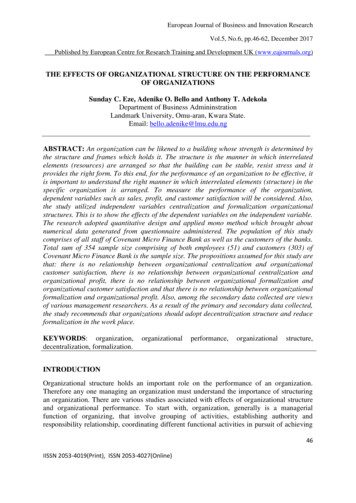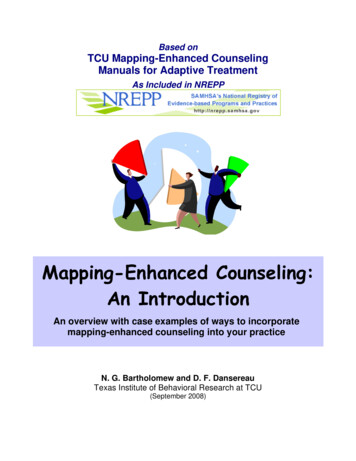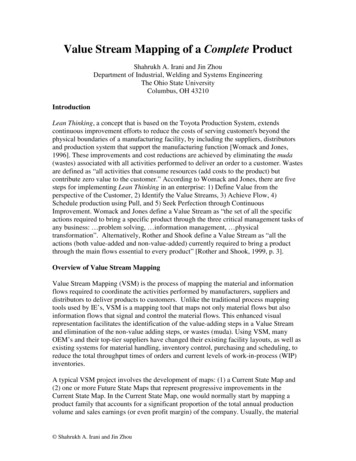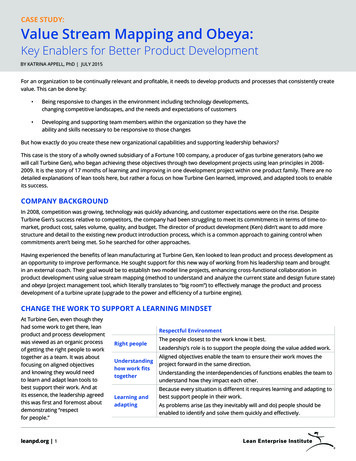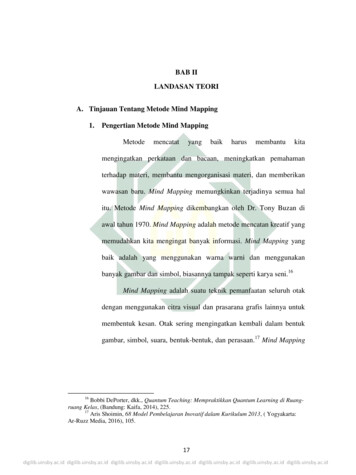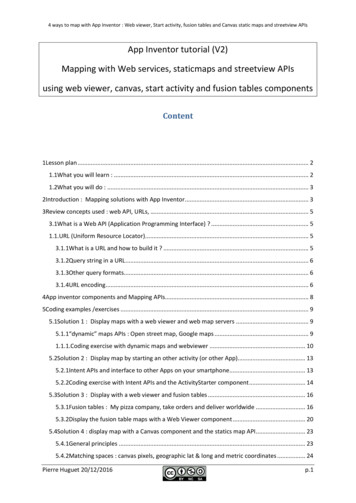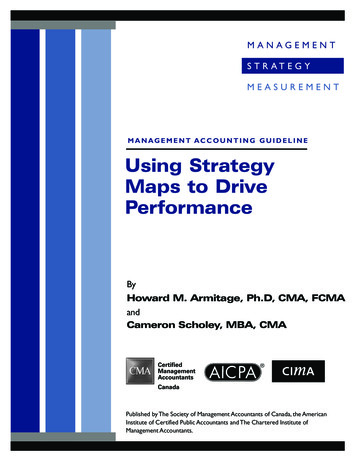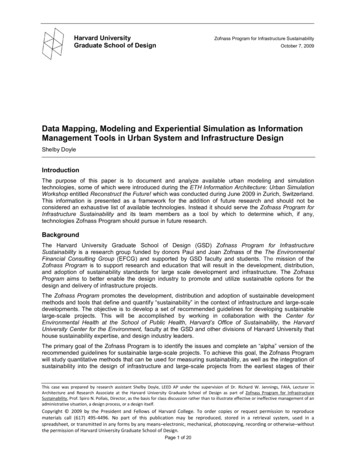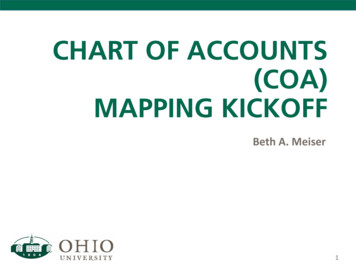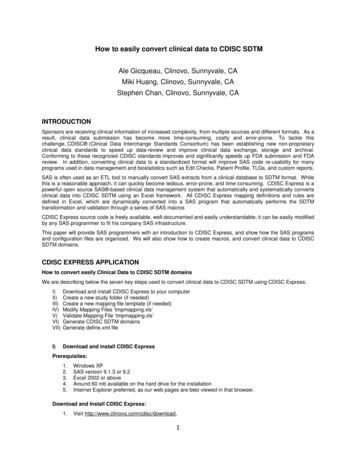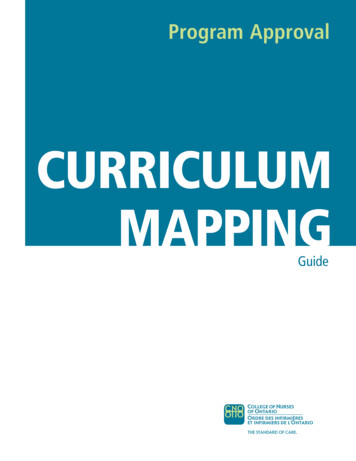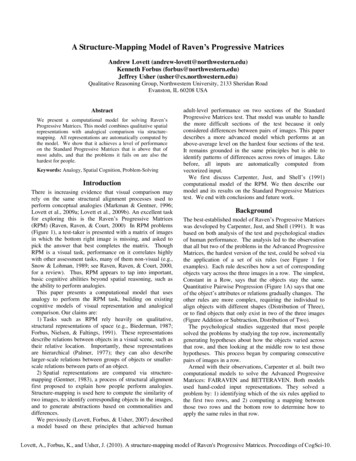
Transcription
A Structure-Mapping Model of Raven’s Progressive MatricesAndrew Lovett (andrew-lovett@northwestern.edu)Kenneth Forbus (forbus@northwestern.edu)Jeffrey Usher (usher@cs.northwestern.edu)Qualitative Reasoning Group, Northwestern University, 2133 Sheridan RoadEvanston, IL 60208 USAAbstractWe present a computational model for solving Raven’sProgressive Matrices. This model combines qualitative spatialrepresentations with analogical comparison via structuremapping. All representations are automatically computed bythe model. We show that it achieves a level of performanceon the Standard Progressive Matrices that is above that ofmost adults, and that the problems it fails on are also thehardest for people.Keywords: Analogy, Spatial Cognition, Problem-SolvingIntroductionThere is increasing evidence that visual comparison mayrely on the same structural alignment processes used toperform conceptual analogies (Markman & Gentner, 1996;Lovett et al., 2009a; Lovett et al., 2009b). An excellent taskfor exploring this is the Raven’s Progressive Matrices(RPM) (Raven, Raven, & Court, 2000) In RPM problems(Figure 1), a test-taker is presented with a matrix of imagesin which the bottom right image is missing, and asked topick the answer that best completes the matrix. ThoughRPM is a visual task, performance on it correlates highlywith other assessment tasks, many of them non-visual (e.g.,Snow & Lohman, 1989; see Raven, Raven, & Court, 2000,for a review). Thus, RPM appears to tap into important,basic cognitive abilities beyond spatial reasoning, such asthe ability to perform analogies.This paper presents a computational model that usesanalogy to perform the RPM task, building on existingcognitive models of visual representation and analogicalcomparison. Our claims are:1) Tasks such as RPM rely heavily on qualitative,structural representations of space (e.g., Biederman, 1987;Forbus, Nielsen, & Faltings, 1991). These representationsdescribe relations between objects in a visual scene, such astheir relative location. Importantly, these representationsare hierarchical (Palmer, 1977); they can also describelarger-scale relations between groups of objects or smallerscale relations between parts of an object.2) Spatial representations are compared via structuremapping (Gentner, 1983), a process of structural alignmentfirst proposed to explain how people perform analogies.Structure-mapping is used here to compute the similarity oftwo images, to identify corresponding objects in the images,and to generate abstractions based on commonalities anddifferences.We previously (Lovett, Forbus, & Usher, 2007) describeda model based on these principles that achieved humanadult-level performance on two sections of the StandardProgressive Matrices test. That model was unable to handlethe more difficult sections of the test because it onlyconsidered differences between pairs of images. This paperdescribes a more advanced model which performs at anabove-average level on the hardest four sections of the test.It remains grounded in the same principles but is able toidentify patterns of differences across rows of images. Likebefore, all inputs are automatically computed fromvectorized input.We first discuss Carpenter, Just, and Shell’s (1991)computational model of the RPM. We then describe ourmodel and its results on the Standard Progressive Matricestest. We end with conclusions and future work.BackgroundThe best-established model of Raven’s Progressive Matriceswas developed by Carpenter, Just, and Shell (1991). It wasbased on both analysis of the test and psychological studiesof human performance. The analysis led to the observationthat all but two of the problems in the Advanced ProgressiveMatrices, the hardest version of the test, could be solved viathe application of a set of six rules (see Figure 1 forexamples). Each rule describes how a set of correspondingobjects vary across the three images in a row. The simplest,Constant in a Row, says that the objects stay the same.Quantitative Pairwise Progression (Figure 1A) says that oneof the object’s attributes or relations gradually changes. Theother rules are more complex, requiring the individual toalign objects with different shapes (Distribution of Three),or to find objects that only exist in two of the three images(Figure Addition or Subtraction, Distribution of Two).The psychological studies suggested that most peoplesolved the problems by studying the top row, incrementallygenerating hypotheses about how the objects varied acrossthat row, and then looking at the middle row to test thosehypotheses. This process began by comparing consecutivepairs of images in a row.Armed with their observations, Carpenter et al. built twocomputational models to solve the Advanced ProgressiveMatrices: FAIRAVEN and BETTERAVEN. Both modelsused hand-coded input representations. They solved aproblem by: 1) identifying which of the six rules applied tothe first two rows, and 2) computing a mapping betweenthose two rows and the bottom row to determine how toapply the same rules in that row.Lovett, A., Forbus, K., and Usher, J. (2010). A structure-mapping model of Raven's Progressive Matrices. Proceedings of CogSci-10.
Carpenter RulesOur ClassificationAnswerABCQuantitative PairwiseProgressionDifferences3Constant in a Row Distribution of ThreeLiteral5Distribution of Three(applies twice)Advanced Literal2DEFDistribution of ThreeFigure Addition orDistribution of Two(applies twice)Subtraction(applies two or three times)Our ClassificationAdvanced LiteralAdvanced DifferencesAdvanced DifferencesAnswer457Figure 1: Several examples of RPM problems. To protect the security of the test, all examples were designed by theauthors. Included are the rules required to solve the problems according to Carpenter et al.’s (1991) classifications.Carpenter RulesBETTERAVEN differed from FAIRAVEN in that itpossessed better goal-management and more advancedstrategies for identifying corresponding objects in a row.Whereas FAIRAVEN could perform at the level of theaverage participant in their subject pool, BETTERAVENmatched the performance of the top participants.Since BETTERAVEN’s development, studies (VodegelMatzen, van der Molen, & Dudink, 1994; Embretson, 1998)have suggested that Carpenter et al.’s rule classification is astrong predictor of the difficulty of a matrix problem:problems that involve the more advanced rules, and thatinvolve multiple rules, are more difficult to solve. In thisrespect, the models have had an important, lasting legacy.Unfortunately, they have two limitations. First, they operateon hand-coded input, hence the problem of generating thespatial representations is not modeled. Carpenter at al.justify this by pointing to the high correlation between RPMand non-spatial tasks, suggesting that perceptual encodingmust not play an important role in the task. However, analternate explanation is that the problem of determining thecorrect spatial representation for solving a matrix relies onencoding and abstraction abilities shared with other, nonvisual modalities. The second drawback is that the six rulesidentified by Carpenter et al. were hard-coded into theirmodels. Thus, the models tell us little about how peoplediscover those rules in the first place. That is, how dopeople progress from comparing pairs of images tounderstanding how objects vary across a row?Our model addresses these limitations by using existingmodels of perceptual encoding and comparison. Spatialrepresentations are automatically generated using theCogSketch (Forbus et al., 2008) sketch understandingsystem. These representations are compared via theStructure-Mapping Engine (SME) (Falkenhainer, Forbus, &Gentner, 1989) to generate representations of the pattern ofvariance across a row. We describe each of these systems,beginning with SME as it plays a ubiquitous role in ourmodels of perception and problem-solving.Comparison: Structure-Mapping EngineThe Structure-Mapping Engine (SME) (Falkenhainer,Forbus, & Gentner, 1989) is a computational model ofcomparison based on Gentner’s (1983) structure-mappingtheory. It operates over structured representations, i.e.,symbolic representations consisting of entities, attributes,and relations. Each representation consists of a set of
expressions describing attributes of entities and relationsbetween entities. For example, a representation of the upperleft image in Figure 1B might include an expression statingthat the square contains the circle.Given two such representations, a base and a target, SMEaligns their common relational structure to generate amapping between them. Each mapping consists of: 1)correspondences between elements in the base and targetrepresentations; 2) candidate inferences based onexpressions in one representation that failed to align withanything in the other; 3) a similarity score between the tworepresentations based on the quantity and depth of theiraligned structure. For this model, we normalize similarityscores based on the overall size of the base and target.SME is useful in spatial problem-solving because amapping between two spatial representations can providethree types of information. First, the similarity score givesthe overall similarity of the images. Second, the candidateinferences identity particular differences between theimages. Third, the correspondences can be useful in twoways. (a) Correspondences between expressions identifycommonalities in the representations, and(b)correspondences between entities identify correspondingobjects in the two images, a key piece of information fordetermining how an object varies across a row of images.Finally, SME can take as input constraints on itsmappings, such as requiring particular correspondences,excluding particular correspondences, or requiring thatcertain types of entities only map to similar types. Whilethe psychological support for these constraints is not asstrong as the overall psychological support for SME, wehave found previously (Lovett et al., 2009b) that constraintscan be useful for simulating a preference for aligning similarshapes when comparing images.Perceptual Encoding: CogSketchWe use CogSketch (Forbus et al., 2008) to generate spatialrepresentations. CogSketch is an open-domain sketchunderstanding system. Given a sketch consisting of linedrawings of a set of objects, CogSketch automaticallycomputes qualitative spatial relations between the objects,generating a spatial representation. This representation canthen serve as the input to other reasoning systems.There are two ways of providing input to CogSketch. Auser can either draw out a sketch within CogSketch, orimport a set of shapes created in PowerPoint. In either case,it is the user’s responsibility to segment an image intoobjects—CogSketch does not do this automatically.Essentially, the user is performing part of the job ofperceptual organization (Palmer & Rock, 1994), the lowlevel visual operation that creates a set of entry-level unitsfor processing. We focus on modeling the ways one mustABCFigure 2. A,B: Two arrow shapes. C: Part of an arrow.reorganize these units—via grouping and segmentation—during the problem-solving processes.Sketches can be further segmented by using a sketchlattice, a grid which indicates which objects should begrouped together into images. For example, to import theRaven problems in Figure 1 into CogSketch, one wouldcreate one sketch lattice for each of the two matrices in aproblem, then import the shapes from PowerPoint and placethem in the appropriate locations in each lattice. In this way,a user can specify an RPM problem for CogSketch to solve.Generating RepresentationsGiven a sketch, CogSketch automatically generates a set ofqualitative spatial relations between the objects in it. Theserelations describe the relative position of the objects andtheir topology—i.e., whether two objects intersect, orwhether one is located inside another. CogSketch can alsogenerate attributes describing features of an object, such asits relative size or its degree of symmetry.CogSketch is not limited to generating representations atthe level of objects. It is generally believed that humanrepresentations of space are hierarchical (Palmer, 1977;Palmer & Rock, 1994). While there may be a natural―object‖ level of representation, we can also parse an objectinto a set of parts or group several objects into a larger-scaleset. Similarly, CogSketch can, on demand, generaterepresentations at two other scales: edges and groups.To generate an edge-level representation, CogSketchparses the lines that make up an object into edges. It doesthis by identifying discontinuities in a line’s curvature thatindicate the presence of corners (see Lovett et al., 2009b fordetails). CogSketch then generates qualitative spatialrelations between the edges in a shape, describing relativeorientation, relative length, convexity of corners, etc.To generate a representation at the level of groups,CogSketch groups objects together based on proximity andsimilarity. It can then identify qualitative spatial relationsbetween groups, or between groups and individual objects.Interactions with SMEWe believe structural alignment plays an important role incomparing visual stimuli. CogSketch employs SME todetermine how images relate to each other. However, theuse of hierarchical representations means that SME can alsocompare two objects’ edge-level representations todetermine how the objects relate to each other. Our modeluses this capability in two ways, discussed next.Finding Shape Transformations CogSketch can comparetwo objects’ shapes to identify transformations betweenthem, e.g., the rotation between the arrow shapes in Figure2. It does this via a simple simulation of mental-rotation(Shepard & Metzler, 1971): (1) Two objects’ edge-levelrepresentations are compared via SME. SME’s mappingidentifies the corresponding edges in the two objects. (2)Pairs of corresponding edges are quantitatively compared todetermine whether there is a consistent transformation
between them. In Figure 2, CogSketch could identify arotation or a reflection between the arrows shapes.CogSketch can identify two types of shapetransformations: equivalence transformations (henceforthcalled simply transformations) and deformations.Transformations (rotation, reflection, and changes in overallsize) leave an object’s basic shape unchanged. Deformations(becoming longer/shorter, becoming longer/shorter in a part,adding/losing a part) change the object’s shape.Based on shape comparisons, a given set of objects can begrouped into equivalent shape classes—groups of objectsthat have a valid transformation between them, such asequilateral triangles of all sizes and orientations—and strictshape classes—groups of objects that are identical, such asupright, equilateral triangles of a particular ically segment an object into parts based oncomparisons with other objects. For example, to determinethe relationship between the images in Figures 2A and 2C, itsegments each object into its edges, and uses SME toidentify corresponding edges. Grouping only edges in 2Athat correspond to edges in 2C enables it to segment 2A intotwo objects, one of which is identical to 2C. The differencebetween 2A and 2C is then represented as: A contains thesame object as 2C, but with a second, angular objectlocated above it.Our ModelOur model is based on Carpenter, Shell, and Just’s (1991)finding that people generally begin solving a matrixproblem by comparing adjacent pairs of images in each rowof the problem. Our model begins by comparing the imagesin a row via SME. Based on the mappings between images,it generates a pattern of variance, a representation of howthe objects change across the row of images. The modelthen computes a second-order comparison (Lovett et al.,2009B), using SME to compare the patterns for the top tworows and rate their similarity. If the rows are sufficientlysimilar, the model builds a generalization representing whatis common to them; it then looks for an answer that willallow the bottom row to best match this generalization. Ifthe top two rows are not sufficiently similar, the modelmakes a change to its problem-solving strategy.Instead of identifying RPM-specific rules as Carpenter etal. did, we utilize two general classes of strategies (fourstrategies in all) for how a person might go about buildingpatterns of variance. We believe these strategies should beapplicable to a variety of spatial problems.The two classes of strategies are Differences and Literal.Differences involves representing the differences betweenadjacent pairs of images in a row. For example, in Figure1A the object is gradually getting smaller. Literal involvesrepresenting what is literally true in each image of the row.In Figure 1B, every row contains a square, a circle, and adiamond. There are also advanced versions of each strategy,described below. We now describe each strategy in detail.Differences Strategy1) Generate Representations CogSketch generates aspatial representation for each object in a row. WhileCogSketch can generate representations at multiple levels,the model begins with the highest-scale, and thus simplest,representation. Objects consisting of a single edge—orobjects consisting of multiple edges that don’t form a closedshape—are grouped together based on connectedness toform a single object, e.g., in the first image of Figure 1F, thevertical and diagonal edges are grouped to form a singleobject. Objects consisting of closed shapes are combinedbased on proximity and similarity to form groups, e.g., thesets of three squares in Figure 1F are grouped together.CogSketch then computes spatial relationships between theobjects, and between objects and groups. It also computesobject attributes, describing their shape, color, texture, etc.2) Compute a Basic Pattern of Variance Consecutivepairs of images in the row are compared via SME to identifythe corresponding objects. If there are leftover, unmatchedobjects in both the first and last images of the row, thenthese images are also compared. Corresponding objects arethen compared to identify transformations between theirshapes. Based on these comparisons, the model generatesone of the following expressions to describe how an objectvaries between each pair of images: (a) Identity: The objectremains the same. (b) Transformation: A transformationexists between the shapes. (c) Deformation: A deformationexists between the shapes. (d) Shape Change: The shapeschange entirely. Shape changes are represented as a changebetween two strict shape classes. Essentially, this isequivalent to a person keeping ―square changes to circle‖ inworking memory. (e) Addition/Removal: An object is addedor removed.If an object is identical in every image in the row, thenthis is deemed unimportant, and not explicitly represented1.The rest of these expressions are supplemented by anychanges in the spatial relations and colors of the images, asidentified by SME’s candidate inferences, to produce arepresentation of the pattern of variance across the row.3) Comparison-Based Segmentation For some problems,the appropriate set of objects to consider only becomes clearafter images are compared. For example, in Figure 1E, onediscovers after comparison that the third object in the rowcan be segmented into two parts, such that these partscorrespond to the previous two objects in the row. Ourmodel attempts comparison-based segmentation for a set ofcorresponding objects when: (a) The objects can be brokendown into edges, i.e., they aren’t filled-in shapes. (b) Thereis at least one total shape change between the objects,suggesting that they currently don’t align well. (c) Thechanged shapes share some similar parts, i.e., edges with1Carpenter, Just, and Shell (1991) found that the Constant in aRow rule, in which an object remains identical across a row, didnot contribute to the difficulty of problems, suggesting that peoplesimply ignore objects that don’t change.
similar lengths and orientations. (d) There are no identitymatches between objects.Comparison-based segmentation is performed bybreaking the objects into their edges, comparing their edgesin a new pattern of variance, and then grouping the edgesback together based on which sets of edges correspondacross the images. This approach is key in solving Figure1E. It also allows the model to determine that the verticalline and ―X‖ shape are separate objects in Figure 1F. Asimilar approach is used to segment groups into subgroupsor individual objects when they misalign.4) Compute Final Pattern of Variance Repeat step 2) aftersegmentation and regrouping.Advanced Differences StrategyThe advanced differences strategy is identical, except that insteps 3-4, SME mapping constraints are used so that objectsonly map to other objects in the same strict shape class (i.e.,identical objects). Additionally, objects consisting of singleedges (as when the shapes in Figure 1E are broken downinto their edges) can only map to other single-edged objectsat the same relative location in the image. This means themodel will never find object transformations, but it willoften find object additions/removals, making it ideal forsolving problems like 1E and 1F, in which each object isonly present in two of the images in a row.Literal StrategyThe literal strategy represents what is present in each imagein a row, rather than what is different between images. Itbegins by comparing images to identify any features foundin all three images (e.g., the inner shapes in Figure 1B). Itabstracts these features out, representing only the features ineach image that are not constant across the row. If an objecthas a different shape from other corresponding objects in therow (e.g., the outer shapes in Figure 1B), then the modelincludes that object’s strict shape class in the representation.Advanced Literal StrategyThe advanced literal strategy begins by applying the basicliteral strategy. It then removes any references to the imagesin which the objects are found. Spatial relations betweenobjects are also abstracted out. Thus, each object isrepresented independently, and allowed to matchindependently from the other objects in its image (e.g.,Figure 1D). Alternatively, if each image contains only asingle object, then an object is split up and each of itsattributes are represented as a separate entity (Figure 1C).Choosing the Best StrategyOur model evaluates a strategy by computing patterns ofvariance for the top two rows and using SME to comparethem and rate their similarity. If the similarity is above athreshold, the strategy is deemed a success. If not, adifferent strategy is tried. The strategies are tried in thefollowing order, which approximates simplest to mostcomplex: Differences, Literal, Advanced Literal, AdvancedDifferences. If no strategy meets criterion, the model pickswhichever Differences strategy receives the highest score—Literal strategies that fail to meet criterion are notconsidered, since by definition they expect a near-identicalmatch between rows.Selecting an AnswerOnce a strategy is chosen, the model compares the pattern ofvariance for the top two rows to construct an analogicalgeneralization (Kuehne et al., 2000), describing what iscommon to both rows. The model then scores each of theeight possible answers. An answer is scored by insertingthat answer into the bottom row, computing a pattern ofvariance, and then using SME to compare this to thegeneralization for the top two rows. The highest-scoringanswer is selected. In cases of ties, no answer is selected.Solving 2x2 MatricesThe easier RPM sections involve 2x2 matrices. The modelsolves these by simply computing a Differences pattern ofvariance for the top row, and then selecting the best answerfor the bottom row. If no answer scores above a criterion,the model attempts one strategy change: looking downcolumns, instead of across rows, to solve the problem.EvaluationWe evaluated our model by running it on sections B-E ofthe Standard Progressive Matrices test, for a total of 48problems. Only section A was not attempted, as this sectionrelies more on basic perceptual ability and less onanalogical reasoning. While section B uses 2x2 matrices,sections C-E use 3x3 matrices of increasing difficulty.Each problem from the test was recreated in PowerPointand then imported into CogSketch. The experimenterssegmented images into objects based on the Gestaltgrouping principles (Palmer & Rock, 1994).3 Recall that themodel reorganizes the images into new sets of objects asnecessary to solve a problem.ResultsOverall, the model correctly solved 44/48 problems. Tocompare this level of performance to people, we convertedthis score to a 56/60 on the overall test, as individuals whoperformed this well on the later sections typically got a12/12 on section A (Raven et al., 2000, Table SPM2). Ascore of 56/60 is in the 75th percentile for American adults,according to the 1993 norms (Table SPM13).If our model captures the way people perform the test,then problems that are hard for the model should also behard for people. The four missed problems were among thesix hardest problems for human participants, according to1993 norms (Raven, et al., 2000, Table RS3C3).3In one problem, a dotted line was replaced with a gray line forsimplicity.
DiscussionOverall, our model matched the performance of aboveaverage American adults on the Standard ProgressiveMatrices, both in the problems that it got right and theproblems that it missed. Thus, it demonstrates thatqualitative representations and the Structure-MappingEngine can be used to model the performance of typicalparticipants on this task. Importantly, structure mappingplayed a ubiquitous role in the model; it was used tocompare objects, images, and patterns of variance.Additionally, these comparisons were used to ratesimilarities, identify differences, find correspondingelements, and produce generalizations. Thus, the simulationdemonstrates that a single mechanism can be used toperform all the necessary comparisons in this complex task.Direct comparison with BETTERAVEN (Carpenter, Just,& Shell, 1990) is impossible, as it was only built for, andrun on, the Advanced Progressive Matrices. However, if weapply the principles of the model and assume perfectperformance, it would achieve a 59/60, missing one of theproblems missed by our model. Of the other three problemsour model missed, two were due to insufficiencies in itsrepresentations of object and group attributes. Because itcomputes its own representations, our model provides areason that these problems are more difficult for people, i.e.they require encoding more advanced attributes. Thus,while our model might solve fewer problems, its failurespredict and explain human performance.Future WorkWe have shown that our approach is sufficient for modelinghuman performance on Raven’s Progressive Matrices. Animportant further step is to use the model to make newdiscoveries about how people perform spatial problemsolving. In a previous study (Lovett & Forbus, 2009), weused a similar model to identify possible cultural differencesin the ways people represent space. RPM provides a numberof unique opportunities to look at both spatial representationand analogical comparison, due to the complexity anddiversity of the problems. By classifying problems based onthe model strategies and model components required tosolve them, we hope to gain a better understanding of boththe factors that make one problem harder than another, andthe cognitive abilities that make one person better thananother at spatial problem-solving.AcknowledgmentsThis work was supported by NSF SLC Grant SBE-0541957,the Spatial Intelligence and Learning Center (SILC).ReferencesBiederman, I. (1987). Recognition-by-components: Atheory of human image understanding. PsychologicalReview, 94, 115-147.Carpenter, P. A., Just, M. A., & Shell, P. (1990). What oneintelligence test measures: A theoretical account of theprocessing in the Raven Progressive Matrices test.Psychological Review, 97(3), 404-431.Embretson, S. E. (1998). A cognitive design systemapproach to generating valid tests: Application to abstractreasoning. Psychological Methods, 3(3), 380-396.Falkenhainer, B., Forbus, K., & Gentner, D. (1989). Thestructuremappingengine:Algorithmandexamples. Artificial Intelligence, 41, 1-63.Forbus, K., Nielsen, P., and Faltings, B. (1991). Qualitativespatial reasoning: The CLOCK project. ArtificialIntelligence, 51(1-3), 417-471.Forbus, K., Usher, J., Lovett, A., Lockwood, K., & Wetzel,J. (2008). CogSketch: Open-domain sketch ation. Proceedings of the Fifth EurographicsWorkshop on Sketch-Based Interfaces and Modeling.Kuehne, S., Forbus, K., Gentner, D., & Quinn, B.(2000). SEQL: Category learning as progressiveabstraction using structure mapping. Proceedings of the22nd Annual Conference of the Cognitive Science Society.Lovett, A., Lockwood, K., & Forbus, K. (2008). Modelingcross-cultural performance on the visual odditytask. Proceedings of Spatial Cognition 2008.Lovett, A. Forbus, K., & Usher, J. (2007). Analogy withqualitative spatial representations can simulate solvingRaven's Progressive Matrices. Proceedings of the 29thAnnual Conference of the Cognitive Science Society.Lovett, A., Gentner, D., Forbus, K., & Sagi, E. (2009a).Using analogical mapping to simulate time-coursephenomena in perceptual similarity. Cognitive SystemsResearch 10(3): Special Issue on Analogies - IntegratingCognitive Abilities, 216-228.Lovett, A., Tomai, E., Forbus, K., & Usher, J. (2009b).Solving geometric analogy problems through two-stageanalogical mapping. Cognitive Science 33(7), 1192-1231.Markman, A. B., & Gentner, D. (1996). Commonalities anddifferences in similarity comparisons. Memory &Cognition, 24(2), 235-249.Palmer, S. E. (1977). Hierarchical structure in perceptualrepresentation.
(RPM) (Raven, Raven, & Court, 2000) In RPM problems (Figure 1), a test-taker is presented with a matrix of images in which the bottom right image is missing, and asked to pick the answer that best completes the matrix. Though RPM is a visual task, performance on it correlates highly with other assessment tasks, many of them non-visual (e.g., .

